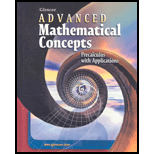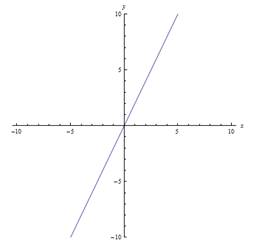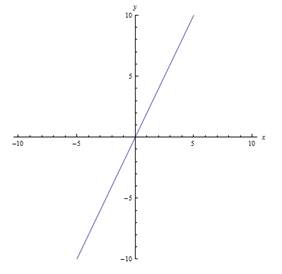
Advanced Mathematical Concepts: Precalculus with Applications, Student Edition
1st Edition
ISBN: 9780078682278
Author: McGraw-Hill, Berchie Holliday
Publisher: Glencoe/McGraw-Hill
expand_more
expand_more
format_list_bulleted
Concept explainers
Question
Chapter 1, Problem 35SGA
To determine
To graph:
Expert Solution & Answer
Answer to Problem 35SGA

Explanation of Solution
Given information:
Calculation:
Put
The value of x-intercept is
Put
The value of y-intercept is
The graph for given equation is plotted below.

Chapter 1 Solutions
Advanced Mathematical Concepts: Precalculus with Applications, Student Edition
Ch. 1.1 - Prob. 1CFUCh. 1.1 - Prob. 2CFUCh. 1.1 - Prob. 3CFUCh. 1.1 - Prob. 4CFUCh. 1.1 - Prob. 5CFUCh. 1.1 - Prob. 6CFUCh. 1.1 - Prob. 7CFUCh. 1.1 - Prob. 8CFUCh. 1.1 - Prob. 9CFUCh. 1.1 - Prob. 10CFU
Ch. 1.1 - Prob. 11CFUCh. 1.1 - Prob. 12CFUCh. 1.1 - Prob. 13CFUCh. 1.1 - Prob. 14CFUCh. 1.1 - Prob. 15CFUCh. 1.1 - Prob. 16CFUCh. 1.1 - Prob. 17ECh. 1.1 - Prob. 18ECh. 1.1 - Prob. 19ECh. 1.1 - Prob. 20ECh. 1.1 - Prob. 21ECh. 1.1 - Prob. 22ECh. 1.1 - Prob. 23ECh. 1.1 - Prob. 24ECh. 1.1 - Prob. 25ECh. 1.1 - Prob. 26ECh. 1.1 - Prob. 27ECh. 1.1 - Prob. 28ECh. 1.1 - Prob. 29ECh. 1.1 - Prob. 30ECh. 1.1 - Prob. 31ECh. 1.1 - Prob. 32ECh. 1.1 - Prob. 33ECh. 1.1 - Prob. 34ECh. 1.1 - Prob. 35ECh. 1.1 - Prob. 36ECh. 1.1 - Prob. 37ECh. 1.1 - Prob. 38ECh. 1.1 - Prob. 39ECh. 1.1 - Prob. 40ECh. 1.1 - Prob. 41ECh. 1.1 - Prob. 42ECh. 1.1 - Prob. 43ECh. 1.1 - Prob. 44ECh. 1.1 - Prob. 45ECh. 1.1 - Prob. 46ECh. 1.1 - Prob. 47ECh. 1.1 - Prob. 48ECh. 1.1 - Prob. 49ECh. 1.1 - Prob. 50ECh. 1.1 - Prob. 51ECh. 1.1 - Prob. 52ECh. 1.1 - Prob. 53ECh. 1.1 - Prob. 54ECh. 1.1 - Prob. 55ECh. 1.1 - Prob. 56ECh. 1.1 - Prob. 57ECh. 1.2 - Prob. 1GCECh. 1.2 - Prob. 2GCECh. 1.2 - Prob. 3GCECh. 1.2 - Prob. 4GCECh. 1.2 - Prob. 5GCECh. 1.2 - Prob. 1CFUCh. 1.2 - Prob. 2CFUCh. 1.2 - Prob. 3CFUCh. 1.2 - Prob. 4CFUCh. 1.2 - Prob. 5CFUCh. 1.2 - Prob. 6CFUCh. 1.2 - Prob. 7CFUCh. 1.2 - Prob. 8CFUCh. 1.2 - Prob. 9CFUCh. 1.2 - Prob. 10CFUCh. 1.2 - Prob. 11ECh. 1.2 - Prob. 12ECh. 1.2 - Prob. 13ECh. 1.2 - Prob. 14ECh. 1.2 - Prob. 15ECh. 1.2 - Prob. 16ECh. 1.2 - Prob. 17ECh. 1.2 - Prob. 18ECh. 1.2 - Prob. 19ECh. 1.2 - Prob. 20ECh. 1.2 - Prob. 21ECh. 1.2 - Prob. 22ECh. 1.2 - Prob. 23ECh. 1.2 - Prob. 24ECh. 1.2 - Prob. 25ECh. 1.2 - Prob. 26ECh. 1.2 - Prob. 27ECh. 1.2 - Prob. 28ECh. 1.2 - Prob. 29ECh. 1.2 - Prob. 30ECh. 1.2 - Prob. 31ECh. 1.2 - Prob. 32ECh. 1.2 - Prob. 33ECh. 1.2 - Prob. 34ECh. 1.2 - Prob. 35ECh. 1.2 - Prob. 36ECh. 1.2 - Prob. 37ECh. 1.2 - Prob. 38ECh. 1.2 - Prob. 39ECh. 1.3 - Prob. 1CFUCh. 1.3 - Prob. 2CFUCh. 1.3 - Prob. 3CFUCh. 1.3 - Prob. 4CFUCh. 1.3 - Prob. 5CFUCh. 1.3 - Prob. 6CFUCh. 1.3 - Prob. 7CFUCh. 1.3 - Prob. 8CFUCh. 1.3 - Prob. 9CFUCh. 1.3 - Prob. 10CFUCh. 1.3 - Prob. 11CFUCh. 1.3 - Prob. 12ECh. 1.3 - Prob. 13ECh. 1.3 - Prob. 14ECh. 1.3 - Prob. 15ECh. 1.3 - Prob. 16ECh. 1.3 - Prob. 17ECh. 1.3 - Prob. 18ECh. 1.3 - Prob. 19ECh. 1.3 - Prob. 20ECh. 1.3 - Prob. 21ECh. 1.3 - Prob. 22ECh. 1.3 - Prob. 23ECh. 1.3 - Prob. 24ECh. 1.3 - Prob. 25ECh. 1.3 - Prob. 26ECh. 1.3 - Prob. 27ECh. 1.3 - Prob. 28ECh. 1.3 - Prob. 29ECh. 1.3 - Prob. 30ECh. 1.3 - Prob. 31ECh. 1.3 - Prob. 32ECh. 1.3 - Prob. 33ECh. 1.3 - Prob. 34ECh. 1.3 - Prob. 35ECh. 1.3 - Prob. 36ECh. 1.3 - Prob. 37ECh. 1.3 - Prob. 38ECh. 1.3 - Prob. 39ECh. 1.3 - Prob. 40ECh. 1.3 - Prob. 41ECh. 1.3 - Prob. 42ECh. 1.3 - Prob. 43ECh. 1.3 - Prob. 44ECh. 1.3 - Prob. 45ECh. 1.3 - Prob. 46ECh. 1.3B - Prob. 1GCECh. 1.3B - Prob. 2GCECh. 1.3B - Prob. 3GCECh. 1.4 - Prob. 1CFUCh. 1.4 - Prob. 2CFUCh. 1.4 - Prob. 3CFUCh. 1.4 - Prob. 4CFUCh. 1.4 - Prob. 5CFUCh. 1.4 - Prob. 6CFUCh. 1.4 - Prob. 7CFUCh. 1.4 - Prob. 8CFUCh. 1.4 - Prob. 9CFUCh. 1.4 - Prob. 10CFUCh. 1.4 - Prob. 11ECh. 1.4 - Prob. 12ECh. 1.4 - Prob. 13ECh. 1.4 - Prob. 14ECh. 1.4 - Prob. 15ECh. 1.4 - Prob. 16ECh. 1.4 - Prob. 17ECh. 1.4 - Prob. 18ECh. 1.4 - Prob. 19ECh. 1.4 - Prob. 20ECh. 1.4 - Prob. 21ECh. 1.4 - Prob. 22ECh. 1.4 - Prob. 23ECh. 1.4 - Prob. 24ECh. 1.4 - Prob. 25ECh. 1.4 - Prob. 26ECh. 1.4 - Prob. 27ECh. 1.4 - Prob. 28ECh. 1.4 - Prob. 29ECh. 1.4 - Prob. 30ECh. 1.4 - Prob. 31ECh. 1.4 - Prob. 32ECh. 1.4 - Prob. 33ECh. 1.4 - Prob. 34ECh. 1.4 - Prob. 35ECh. 1.4 - Prob. 1MCQCh. 1.4 - Prob. 2MCQCh. 1.4 - Prob. 3MCQCh. 1.4 - Prob. 4MCQCh. 1.4 - Prob. 5MCQCh. 1.4 - Prob. 6MCQCh. 1.4 - Prob. 7MCQCh. 1.4 - Prob. 8MCQCh. 1.4 - Prob. 9MCQCh. 1.4 - Prob. 10MCQCh. 1.5 - Prob. 1CFUCh. 1.5 - Prob. 2CFUCh. 1.5 - Prob. 3CFUCh. 1.5 - Prob. 4CFUCh. 1.5 - Prob. 5CFUCh. 1.5 - Prob. 6CFUCh. 1.5 - Prob. 7CFUCh. 1.5 - Prob. 8CFUCh. 1.5 - Prob. 9CFUCh. 1.5 - Prob. 10CFUCh. 1.5 - Prob. 11CFUCh. 1.5 - Prob. 12ECh. 1.5 - Prob. 13ECh. 1.5 - Prob. 14ECh. 1.5 - Prob. 15ECh. 1.5 - Prob. 16ECh. 1.5 - Prob. 17ECh. 1.5 - Prob. 18ECh. 1.5 - Prob. 19ECh. 1.5 - Prob. 20ECh. 1.5 - Prob. 21ECh. 1.5 - Prob. 22ECh. 1.5 - Prob. 23ECh. 1.5 - Prob. 24ECh. 1.5 - Prob. 25ECh. 1.5 - Prob. 26ECh. 1.5 - Prob. 27ECh. 1.5 - Prob. 28ECh. 1.5 - Prob. 29ECh. 1.5 - Prob. 30ECh. 1.5 - Prob. 31ECh. 1.5 - Prob. 32ECh. 1.5 - Prob. 33ECh. 1.5 - Prob. 34ECh. 1.5 - Prob. 35ECh. 1.5 - Prob. 36ECh. 1.5 - Prob. 37ECh. 1.5 - Prob. 38ECh. 1.5 - Prob. 39ECh. 1.5 - Prob. 40ECh. 1.6 - Prob. 1CFUCh. 1.6 - Prob. 2CFUCh. 1.6 - Prob. 3CFUCh. 1.6 - Prob. 4CFUCh. 1.6 - Prob. 5CFUCh. 1.6 - Prob. 6ECh. 1.6 - Prob. 7ECh. 1.6 - Prob. 8ECh. 1.6 - Prob. 9ECh. 1.6 - Prob. 10ECh. 1.6 - Prob. 11ECh. 1.6 - Prob. 12ECh. 1.6 - Prob. 13ECh. 1.6 - Prob. 14ECh. 1.6 - Prob. 15ECh. 1.6 - Prob. 16ECh. 1.6 - Prob. 17ECh. 1.6 - Prob. 18ECh. 1.6 - Prob. 19ECh. 1.7 - Prob. 1CFUCh. 1.7 - Prob. 2CFUCh. 1.7 - Prob. 3CFUCh. 1.7 - Prob. 4CFUCh. 1.7 - Prob. 5CFUCh. 1.7 - Prob. 6CFUCh. 1.7 - Prob. 7CFUCh. 1.7 - Prob. 8CFUCh. 1.7 - Prob. 9CFUCh. 1.7 - Prob. 10CFUCh. 1.7 - Prob. 11ECh. 1.7 - Prob. 12ECh. 1.7 - Prob. 13ECh. 1.7 - Prob. 14ECh. 1.7 - Prob. 15ECh. 1.7 - Prob. 16ECh. 1.7 - Prob. 17ECh. 1.7 - Prob. 18ECh. 1.7 - Prob. 19ECh. 1.7 - Prob. 20ECh. 1.7 - Prob. 21ECh. 1.7 - Prob. 22ECh. 1.7 - Prob. 23ECh. 1.7 - Prob. 24ECh. 1.7 - Prob. 25ECh. 1.7 - Prob. 26ECh. 1.7 - Prob. 27ECh. 1.7 - Prob. 28ECh. 1.7 - Prob. 29ECh. 1.7 - Prob. 30ECh. 1.7 - Prob. 31ECh. 1.7 - Prob. 32ECh. 1.7 - Prob. 33ECh. 1.7 - Prob. 34ECh. 1.7 - Prob. 35ECh. 1.7 - Prob. 36ECh. 1.7 - Prob. 37ECh. 1.8 - Prob. 1CFUCh. 1.8 - Prob. 2CFUCh. 1.8 - Prob. 3CFUCh. 1.8 - Prob. 4CFUCh. 1.8 - Prob. 5CFUCh. 1.8 - Prob. 6CFUCh. 1.8 - Prob. 7CFUCh. 1.8 - Prob. 8CFUCh. 1.8 - Prob. 9ECh. 1.8 - Prob. 10ECh. 1.8 - Prob. 11ECh. 1.8 - Prob. 12ECh. 1.8 - Prob. 13ECh. 1.8 - Prob. 14ECh. 1.8 - Prob. 15ECh. 1.8 - Prob. 16ECh. 1.8 - Prob. 17ECh. 1.8 - Prob. 18ECh. 1.8 - Prob. 19ECh. 1.8 - Prob. 20ECh. 1.8 - Prob. 21ECh. 1.8 - Prob. 22ECh. 1.8 - Prob. 23ECh. 1.8 - Prob. 24ECh. 1.8 - Prob. 25ECh. 1.8 - Prob. 26ECh. 1.8 - Prob. 27ECh. 1.8 - Prob. 28ECh. 1.8 - Prob. 29ECh. 1.8 - Prob. 30ECh. 1.8 - Prob. 31ECh. 1.8 - Prob. 32ECh. 1 - Prob. 1SGACh. 1 - Prob. 2SGACh. 1 - Prob. 3SGACh. 1 - Prob. 4SGACh. 1 - Prob. 5SGACh. 1 - Prob. 6SGACh. 1 - Prob. 7SGACh. 1 - Prob. 8SGACh. 1 - Prob. 9SGACh. 1 - Prob. 10SGACh. 1 - Prob. 11SGACh. 1 - Prob. 12SGACh. 1 - Prob. 13SGACh. 1 - Prob. 14SGACh. 1 - Prob. 15SGACh. 1 - Prob. 16SGACh. 1 - Prob. 17SGACh. 1 - Prob. 18SGACh. 1 - Prob. 19SGACh. 1 - Prob. 20SGACh. 1 - Prob. 21SGACh. 1 - Prob. 22SGACh. 1 - Prob. 23SGACh. 1 - Prob. 24SGACh. 1 - Prob. 25SGACh. 1 - Prob. 26SGACh. 1 - Prob. 27SGACh. 1 - Prob. 28SGACh. 1 - Prob. 29SGACh. 1 - Prob. 30SGACh. 1 - Prob. 31SGACh. 1 - Prob. 32SGACh. 1 - Prob. 33SGACh. 1 - Prob. 34SGACh. 1 - Prob. 35SGACh. 1 - Prob. 36SGACh. 1 - Prob. 37SGACh. 1 - Prob. 38SGACh. 1 - Prob. 39SGACh. 1 - Prob. 40SGACh. 1 - Prob. 41SGACh. 1 - Prob. 42SGACh. 1 - Prob. 43SGACh. 1 - Prob. 44SGACh. 1 - Prob. 45SGACh. 1 - Prob. 46SGACh. 1 - Prob. 47SGACh. 1 - Prob. 48SGACh. 1 - Prob. 49SGACh. 1 - Prob. 50SGACh. 1 - Prob. 51SGACh. 1 - Prob. 52SGACh. 1 - Prob. 53SGACh. 1 - Prob. 54SGACh. 1 - Prob. 55SGACh. 1 - Prob. 56SGACh. 1 - Prob. 57SGACh. 1 - Prob. 58SGACh. 1 - Prob. 59SGACh. 1 - Prob. 60SGACh. 1 - Prob. 61SGACh. 1 - Prob. 62SGACh. 1 - Prob. 63SGACh. 1 - Prob. 64SGACh. 1 - Prob. 65SGACh. 1 - Prob. 66SGACh. 1 - Prob. 67SGACh. 1 - Prob. 68SGACh. 1 - Prob. 69SGACh. 1 - Prob. 1SAPCh. 1 - Prob. 2SAPCh. 1 - Prob. 3SAPCh. 1 - Prob. 4SAPCh. 1 - Prob. 5SAPCh. 1 - Prob. 6SAPCh. 1 - Prob. 7SAPCh. 1 - Prob. 8SAPCh. 1 - Prob. 9SAPCh. 1 - Prob. 10SAP
Additional Math Textbook Solutions
Find more solutions based on key concepts
Student Ages The mean age of all 2550 students at a small college is 22.8 years with a standard deviation is 3....
Introductory Statistics
Evaluate the integrals in Exercises 17–66.
17.
University Calculus: Early Transcendentals (4th Edition)
Applying the Intermediate Value Theorem a. Use the Intermediate Value Theorem to show that the following equati...
Calculus: Early Transcendentals (2nd Edition)
A pair of fair dice is rolled. What is the probability that the second die lands on a higher value than does th...
A First Course in Probability (10th Edition)
Calculate probability of finding white sock from drawer.
Pre-Algebra Student Edition
In hypothesis testing, the common level of significance is =0.05. Some might argue for a level of significance ...
Basic Business Statistics, Student Value Edition
Knowledge Booster
Learn more about
Need a deep-dive on the concept behind this application? Look no further. Learn more about this topic, calculus and related others by exploring similar questions and additional content below.Similar questions
- Consider the function f(x) = x²-1. (a) Find the instantaneous rate of change of f(x) at x=1 using the definition of the derivative. Show all your steps clearly. (b) Sketch the graph of f(x) around x = 1. Draw the secant line passing through the points on the graph where x 1 and x-> 1+h (for a small positive value of h, illustrate conceptually). Then, draw the tangent line to the graph at x=1. Explain how the slope of the tangent line relates to the value you found in part (a). (c) In a few sentences, explain what the instantaneous rate of change of f(x) at x = 1 represents in the context of the graph of f(x). How does the rate of change of this function vary at different points?arrow_forward1. The graph of ƒ is given. Use the graph to evaluate each of the following values. If a value does not exist, state that fact. и (a) f'(-5) (b) f'(-3) (c) f'(0) (d) f'(5) 2. Find an equation of the tangent line to the graph of y = g(x) at x = 5 if g(5) = −3 and g'(5) = 4. - 3. If an equation of the tangent line to the graph of y = f(x) at the point where x 2 is y = 4x — 5, find ƒ(2) and f'(2).arrow_forwardDoes the series converge or divergearrow_forward
- Suppose that a particle moves along a straight line with velocity v (t) = 62t, where 0 < t <3 (v(t) in meters per second, t in seconds). Find the displacement d (t) at time t and the displacement up to t = 3. d(t) ds = ["v (s) da = { The displacement up to t = 3 is d(3)- meters.arrow_forwardLet f (x) = x², a 3, and b = = 4. Answer exactly. a. Find the average value fave of f between a and b. fave b. Find a point c where f (c) = fave. Enter only one of the possible values for c. c=arrow_forwardplease do Q3arrow_forward
- Use the properties of logarithms, given that In(2) = 0.6931 and In(3) = 1.0986, to approximate the logarithm. Use a calculator to confirm your approximations. (Round your answers to four decimal places.) (a) In(0.75) (b) In(24) (c) In(18) 1 (d) In ≈ 2 72arrow_forwardFind the indefinite integral. (Remember the constant of integration.) √tan(8x) tan(8x) sec²(8x) dxarrow_forwardFind the indefinite integral by making a change of variables. (Remember the constant of integration.) √(x+4) 4)√6-x dxarrow_forward
arrow_back_ios
SEE MORE QUESTIONS
arrow_forward_ios
Recommended textbooks for you
 Calculus: Early TranscendentalsCalculusISBN:9781285741550Author:James StewartPublisher:Cengage Learning
Calculus: Early TranscendentalsCalculusISBN:9781285741550Author:James StewartPublisher:Cengage Learning Thomas' Calculus (14th Edition)CalculusISBN:9780134438986Author:Joel R. Hass, Christopher E. Heil, Maurice D. WeirPublisher:PEARSON
Thomas' Calculus (14th Edition)CalculusISBN:9780134438986Author:Joel R. Hass, Christopher E. Heil, Maurice D. WeirPublisher:PEARSON Calculus: Early Transcendentals (3rd Edition)CalculusISBN:9780134763644Author:William L. Briggs, Lyle Cochran, Bernard Gillett, Eric SchulzPublisher:PEARSON
Calculus: Early Transcendentals (3rd Edition)CalculusISBN:9780134763644Author:William L. Briggs, Lyle Cochran, Bernard Gillett, Eric SchulzPublisher:PEARSON Calculus: Early TranscendentalsCalculusISBN:9781319050740Author:Jon Rogawski, Colin Adams, Robert FranzosaPublisher:W. H. Freeman
Calculus: Early TranscendentalsCalculusISBN:9781319050740Author:Jon Rogawski, Colin Adams, Robert FranzosaPublisher:W. H. Freeman
 Calculus: Early Transcendental FunctionsCalculusISBN:9781337552516Author:Ron Larson, Bruce H. EdwardsPublisher:Cengage Learning
Calculus: Early Transcendental FunctionsCalculusISBN:9781337552516Author:Ron Larson, Bruce H. EdwardsPublisher:Cengage Learning

Calculus: Early Transcendentals
Calculus
ISBN:9781285741550
Author:James Stewart
Publisher:Cengage Learning

Thomas' Calculus (14th Edition)
Calculus
ISBN:9780134438986
Author:Joel R. Hass, Christopher E. Heil, Maurice D. Weir
Publisher:PEARSON

Calculus: Early Transcendentals (3rd Edition)
Calculus
ISBN:9780134763644
Author:William L. Briggs, Lyle Cochran, Bernard Gillett, Eric Schulz
Publisher:PEARSON

Calculus: Early Transcendentals
Calculus
ISBN:9781319050740
Author:Jon Rogawski, Colin Adams, Robert Franzosa
Publisher:W. H. Freeman


Calculus: Early Transcendental Functions
Calculus
ISBN:9781337552516
Author:Ron Larson, Bruce H. Edwards
Publisher:Cengage Learning
Points, Lines, Planes, Segments, & Rays - Collinear vs Coplanar Points - Geometry; Author: The Organic Chemistry Tutor;https://www.youtube.com/watch?v=dDWjhRfBsKM;License: Standard YouTube License, CC-BY
Naming Points, Lines, and Planes; Author: Florida PASS Program;https://www.youtube.com/watch?v=F-LxiLSSaLg;License: Standard YouTube License, CC-BY